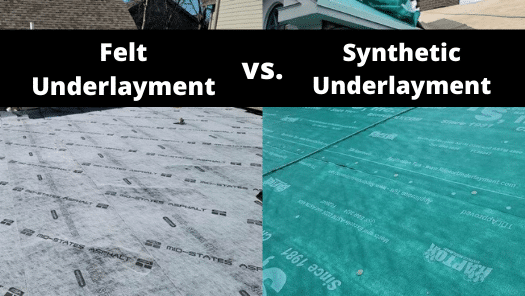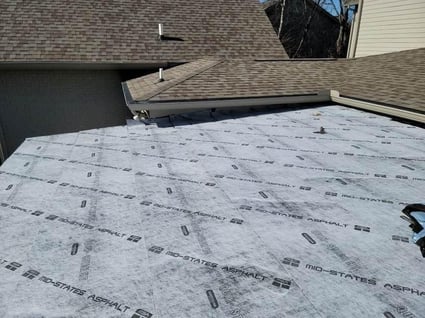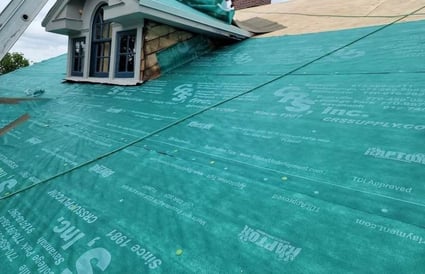Felt Underlayment vs. Synthetic Underlayment: Which is Better?

When getting a replacement, one of the biggest things you’ll have to learn about is the different roofing materials that make up your roof. After all, they have a huge impact on the price.
Because a roof is a sizable purchase, every homeowner needs to know the materials they're about to pay for. One of these important roofing materials is your roof’s underlayment.
Through your research, you’ll find there are two common types of underlayment used for residential roofing. But the question is which one is the best?
We here at Bill Ragan Roofing want you and every homeowner to completely understand their roof investment and what goes into it. To start you down this path, we’re going to break down the crucial roofing material, underlayment.
By the end of this article, you’ll learn what roof underlayment is, the two types, and how they match up on key comparisons, like cost.
What is roof underlayment?
Roof underlayment is the roofing material that lies between your roof decking and your shingles. It’s installed on your roof decking and provides an extra layer of protection from the elements.
There are two different types of underlayment, felt and synthetic.
Felt underlayment is the older of the two and comes in 15 lb and 30 lb rolls. The big difference between the two types of felt underlayment is that 30 lb is thicker, stronger, and less likely to tear than 15 lb.

Synthetic underlayment has been around for about 20 years and is made out of woven/spun polyethylene or polypropylene. Both types of underlayment do their job and have their place in the roofing industry.

However, there are some important comparisons to keep in mind when deciding which one you want on your roof.
Felt underlayment vs. synthetic underlayment
When choosing your roof’s underlayment, you have to compare the product’s weight, price, and more. Let’s get to the breakdown of felt underlayment vs. synthetic underlayment.
Which roof underlayment weighs more?
Felt underlayment weighs more than synthetic underlayment. You probably don’t think the weight of the material is an important comparison.
However, the weight of your roof underlayment is going to impact the labor cost of your roof replacement. There’s one main reason why the heavier product adds to the labor cost.
Because felt underlayment is a heavy roofing material, it doesn’t have as much material per roll as synthetic. This leads to needing more of it, which takes more time and manpower to get it up the ladder and install it on your roof.
While this won’t add too much to your labor costs, it’s just something to keep in mind.
Which roof underlayment is safer to work on?
Once your underlayment is laid down, your roofing contractor will start to install the rest of your roofing materials. When they’re doing this, they’re going to have to walk on it.
Synthetic underlayment is made to be non-skid, so it’s a lot safer to work on. This means even as they're walking on it and installing your roofing materials, they’ll feel safe and won’t have to worry about slipping like they would on felt underlayment.
Which roof underlayment is more durable?
Anytime you get a new roof, you’re expecting it to stand up to the elements and last for years to come. With that in mind, synthetic underlayment is more durable than felt underlayment.
Felt underlayment is much more prone to rip from high winds and during the installation process. Synthetic underlayment also holds nails better and repels water instead of absorbing it.
If felt underlayment is exposed to moisture or water, it can absorb it and cause the felt to wrinkle. That’s why shingles need to be installed as soon as the felt underlayment is laid down.
If there’s anything to take away from this section, synthetic underlayment provides added strength and protects your roof from weather better.
Which roof underlayment costs more?
Cost is always the first thing on homeowners’ minds when they hear it’s time for a new roof. Because a roof replacement is an expensive purchase, it’s understandable for pricing to be the biggest concern.
While underlayment doesn’t add to the cost as much as other roofing materials, the two types come at different price points. Felt underlayment is around $5.00 per square (100 square feet), while synthetic underlayment is around $7.00-$10.00 per square.
The cost difference between the two isn’t far apart. However, it’s up to you and your budget when deciding which one is right for you.
Is felt underlayment or synthetic underlayment better?
After reading this, you should have a pretty good idea of which roof underlayment is better. Synthetic underlayment might cost more, but it’s worth the extra durability and the extra protection it provides.
However, if you’re on a really tight budget, felt underlayment might be right for you. The important thing is to talk to your local roofing contractor about your underlayment options and how they’ll ultimately impact the cost of your roof.
The rest of the crucial materials that make up your roof
Now you should know which underlayment is right for you. However, your roof’s underlayment is just one important roofing material that’s part of your entire roof system.
Every homeowner probably thinks they don’t need to know all the different types of roofing materials. But the truth is, they make up a lot of the cost of your new roof.
So, wouldn’t you want to know everything you’re about to pay for when getting a replacement? If you answered yes, you’re in luck because we have another article breaking down the 9 crucial roofing materials that are part of your roof replacement.
Since 1990, the team at Bill Ragan Roofing has provided high-quality roof repairs, roof replacements, and other roofing services to homeowners in the Nashville area. We take pride in everything we do, from answering tough questions about the industry to installing a roof with the attention to detail it requires.
Check out 9 Materials Included With Your Roof Replacement to learn what you’re paying for when you get a new roof.


